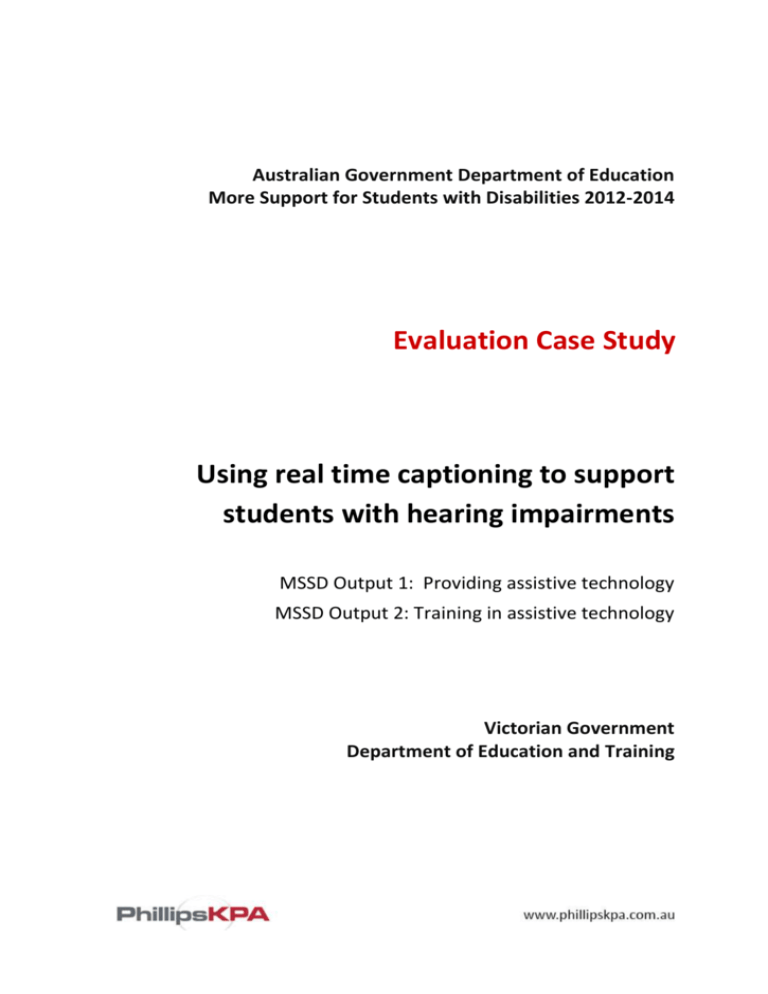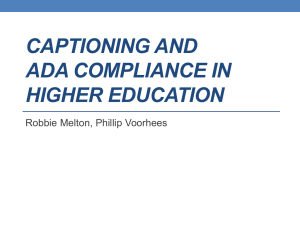Real time captioning in the classroom
advertisement

Australian Government Department of Education More Support for Students with Disabilities 2012-2014 Evaluation Case Study Using real time captioning to support students with hearing impairments MSSD Output 1: Providing assistive technology MSSD Output 2: Training in assistive technology Victorian Government Department of Education and Training Using real time captioning to support students with hearing impairments Abstract In partnership with the Victorian Deaf Education Institute (VDEI), the Victorian Government Department of Education and Training (DET) is trialling and evaluating real time captioning technologies to improve student learning outcomes for hearing impaired students and supporting their integration into mainstream classrooms. This case study describes the introduction of real time captioning and assistive technology systems in a school with the support of a regional deaf facility co-located on campus. Key elements and actions Real time captioning assists hearing impaired students to learn more effectively in a mainstream setting. The system accesses a range of technologies simultaneously so that the hearing impaired student can follow the teacher’s presentation and instructions directly in text form on a tablet, iPad or laptop. The Victorian Government Department of Education and Training (DET) has supported trials of real time captioning and assistive technology systems in eight schools across metropolitan and regional schools for students who are deaf or hard of hearing. The trial is providing direction to inform Victorian policies for inclusive practices for these students. The implementation of captioning systems took place over 2012 and 2013 in two phases across a range of schools in mainstream and specialist settings. The case study school is a relatively small, outer eastern Melbourne suburban secondary college with a regional deaf facility co-located within the school. Twenty-eight of the 550 students have a hearing impairment and qualify for further support under government guidelines. Real time captioning in the classroom The concept of live captioning was taken up about three years prior to the MSSD initiative as a potentially valuable learning aid for hearing impaired students. Discussions were held with the commercial company Ai-Live: Real Time Captioning in the Classroom which provided the real time skilled captioners who listen to the teacher through the Skype link and microphone on the teacher and type what they hear. Using Smartlink microphones, Skype and a web-based iPad display, students are provided with captioned text within seven seconds of the teacher speaking. The class teacher wears a microphone connected via Skype to the trained captioners located off campus, in this case, Sydney. Where relevant the student also has an FM modulator connected to their cochlear implant to enable them, as far as possible, to hear the teacher directly. Access to a tablet, iPad or laptop enables the student to read information and instructions from the teacher in text form almost instantly the teacher speaks. The text is also captured at the end of the session and emailed to the student. These simple and reliable technologies enable students with hearing impairments, teachers and colleagues to engage in lessons as part of the mainstream day. Page 2 of 5 Role of the deaf facility unit The deaf facility at the school is also used for some withdrawal activity for individual students requiring targeted support. In some instances Year 7 hearing impaired students select a subject from the regular timetable that they will be withdrawn from and are then able to attend specific language and literacy lessons with a teacher of the deaf. The student and family are able to negotiate withdrawal from standard subjects at a Student Support Group meeting. Students also have access to a lounge area in the facility throughout the school day where they can go for a special break, speak with a teacher or support person for the hearing impaired, mix with other hearing impaired students and have some personal time out. Appointment of a project manager The school appointed a project manager whose major tasks are to: encourage teaching staff to use the captioning technology in all lessons where hearing impaired students are involved provide professional development training and follow-up support to staff to ensure they feel comfortable and competent in their use of the equipment support the infrastructure that underpins the captioning process keep the school leadership team, parents and students informed about the processes being used and the progress made monitor the impact on student learning assess the value of live captioning. Teacher professional development involved a two day training programme by the external providers followed up by regular and consistent support from the deaf facility leader. The particular skills and understandings focused on such things as: speaking at a pace readily understood by others; knowing how to operate the equipment; and, understanding the privacy implications of the recording process. Role of captioners Live captioning is a relatively simple process. A member of the teaching staff wears a microphone during a lesson, connects the microphone to the dial-in Skype link, and the student receives the text of teacher speech on an iPad. The special skill of the live captioners is to repeat what the teacher says into a voice recognition technology system, which turns the spoken word into text and sends it direct to the student’s iPad. The captioner is able to leave out unnecessary and especially personal comments as needed. The class teacher can ask for ‘caps off‘ when talking to a particular group of students where it is not appropriate for general transcription, and call ‘caps on’ when the translation work is to resume. The student is the only person who receives the print-out of the text via an email attachment following the lesson. Multiple forms of support for students Hearing impaired students are helped in many ways across the school setting, both within the regular class setting as well as specialised withdrawal students to lift the basic skills levels of the hearing impaired. These not only include live captioning, but other forms such as regular captioning to all YouTube and streamed audio-visual resources used across the school to the Page 3 of 5 involvement of Auslan interpreters and education support staff in the classrooms. Specialist teachers of the deaf also work in the classroom, as well as at the deaf facility where they take basic skills lessons concentrated on building up literacy levels to increase the level of student functioning in the regular classroom. Lessons learned Key observations Live captioning has great potential application to improve student access to educational programmes and enhance engagement and participation in classrooms. Teaching staff have readily adopted the technology with minimal adjustments to their teaching style. A positive inclusive approach The positive response to the trial of real time captioning across the college is partly due to the wider inclusiveness approach by the whole school towards hearing impaired students. This had clearly shaped the outputs and outcomes at the time of the site visit. Positive informal and formal relationships between the teaching staff and the specialists employed through the deaf facility are clearly evident. The common link is that everyone sees themselves as contributing to improving the learning opportunities of the hearing impaired students. Maintaining existing practices Senior students accessing the live captioning felt the captioning was helpful to them in a number of ways. One particular advantage was the opportunity to go back over instructions during a lesson to see directly what the teacher had said. Nonetheless students still felt their involvement with their Auslan interpreter was also critical in their understanding of what was being said in the class since the interpreter was skilled in conveying nuances and intent of teacher instructions rather than relying on just a literal translation. Gains in independent learning Given the short time real time captioning has been in place it is not possible to provide direct evidence of improved student learning outcomes. However, teachers commented on the gains they observed in student self-worth. This was largely the result of a greater sense of independence, a reduction in feelings of isolation, and a recognition by the students themselves that they can benefit in their learning through the captioning system. Teachers also report greater motivation of students to work towards higher levels of achievement with the extra support and the students feel better able to access learning more effectively as a direct result of live captioning. Both mainstream and deaf facility teachers had some reservations about the cost-benefits of real time captioning for younger students. Some thought it may not be necessary or indeed appropriate at all for the primary school setting. These observations seemed to be related more to the style of teaching and pedagogy than the use of the technology. Benefits for teachers There appear to be notable gains for teachers on a number of dimensions: they can assist hearing impaired students more effectively, confident in the knowledge that the student has a better understanding of what is being said; they see more readily the value of an inclusive Page 4 of 5 environment to improve the learning outcomes of students with impairments; and, by using lesson transcripts, they have been encouraged to actively reflect on their teaching practice. The promise of new technologies Beyond the ongoing trial there are opportunities for developing more flexible forms of live captioning to embrace diverse ways of student learning and a range of contexts. For example in discussion-centred learning new approaches to accessing live captioning are being considered to support group work involving all students. Teachers were experimenting with this on limited occasions in the current pilot programme. There are some potential barriers to the effectiveness and sustainability of live captioning, the two most obvious being: technical limitations concerning the reliability of the equipment, such as Skype occasionally dropping out, or a microphone not syncing with the equipment dependence on live captioners which is a relatively high cost resource given that every lesson requires a skilled person translating in real time. Sustainability The participants at the case study school believed that both the identified barriers will be less significant as the technology continues to improve, although it is not clear at this point how soon this will occur. New voice technology is a likely option in the longer term although it has not yet reached the level of sophistication needed so that the class teacher replaces the real time captioner entirely. With cheap and effective technology live captioning could obviously be of special value to the hearing impaired, but arguably of value to all students. Potential for adoption in other contexts There is high potential for the actions of this school to be adopted in other settings. This is based on some critical assumptions, such as the capacity of the school to resource the costs, resolving issues around storage of transcripts and access, and minimal time required to train teachers to use the equipment. Notes The methodology for this case study involved a site visit to the secondary school in June 2013 to observe the use of live captioning technology in the classroom, and to discuss the technology and its impact with both the teachers and two senior students using the technology. Page 5 of 5


![Community safeguards inquiry (2014) [DOCX 54 KB]](http://s3.studylib.net/store/data/006784762_1-337e9c809ec9a503c5cf314fa54c9244-300x300.png)

